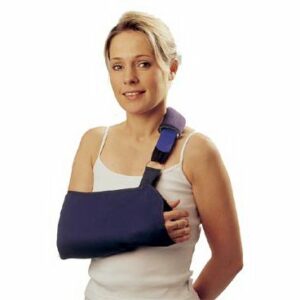Metacarpal Fracture
Updated:
(Also known as a Fractured Metacarpal)
What is a metacarpal fracture?
A metacarpal fracture is a relatively common condition characterised by a break in one of the long bones of the hand known as the metacarpals (figure 1).
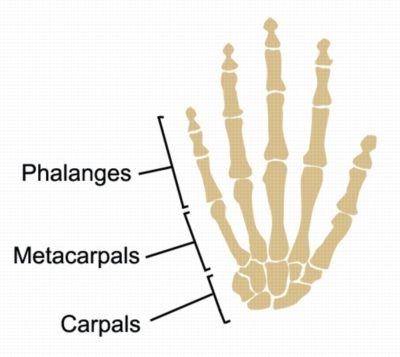
The bones of the palm of the hand primarily include 5 long bones known as the metacarpals (figure 1). The metacarpal bones form joints with the small bones of the wrist known as the carpal bones and the small bones of the fingers known as the phalanges (figure 1).
During certain activities such as a punch or direct impact to the hand, stress is placed on the metacarpal bones. When this stress is traumatic and beyond what the bone(s) can withstand a break in one or more metacarpals may occur. This condition is known as a metacarpal fracture.
Due to the relatively large forces required to break a metacarpal bone, a metacarpal fracture is often seen in association with other injuries to the wrist or fingers such as joint sprains, dislocations or other fractures of the hand or wrist.
Metacarpal fractures can be divided into fractures of the metacarpal head, neck and shaft. Each fracture can vary in location, severity and type including displaced fracture, un-displaced fracture, compound fracture, greenstick, comminuted etc.
Appropriate treatment and management for each fracture is determined by a number of factors including:
- Which metacarpal bone is involved (the 5th metatarsal bone is most commonly fractured)
- The location of the fracture (the metatarsal neck is the most common fracture site)
- The degree of angulation of each fracture (with acceptable angulation varying by location)
- The presence or absence of malrotation (with no degree of malrotation being acceptable)
Metacarpal fractures account for 18 – 44% of all hand injuries and most commonly affect males between the ages of 10 – 29 years.
Cause of a metacarpal fracture
A metacarpal fracture most commonly occurs as a result of a punch (particularly into a hard object). Occasionally they may occur due to a direct impact to the hand from an object travelling at high speed (such as a hockey stick or cricket ball) or a fall onto the fingers or thumb. High speed injuries such as a motor vehicle accident may result in multiple fractures.
Signs and symptoms of a metacarpal fracture
Patients with this condition typically experience a sudden onset of intense hand pain at the time of injury. Pain may be felt on the front, back or sides of the hand and can occasionally settle quickly leaving patients with an achiness of the hand that is particularly prominent at night or first thing in the morning. Pain may also radiate into the fingers or wrist of the affected hand.
Patients with a metacarpal fracture may also experience weakness, swelling, bruising and pain on firmly touching the affected region of bone. Pain may also increase with certain movements of the wrist and fingers such as opening and closing the hand and fingers, general gripping activity, lifting, carrying objects and pushing through the affected hand. In severe metacarpal fractures with bony displacement, an obvious deformity may be present. Occasionally, patients may also experience pins and needles or numbness in the hand or fingers.
Diagnosis of a metacarpal fracture
A thorough subjective and objective examination from a physiotherapist, doctor or orthopaedic surgeon is essential to assist with diagnosis of a metacarpal fracture. X-rays are usually required to confirm diagnosis and assess the severity. Further investigations such as a CT scan, MRI, or bone scan may be required, in some cases, to assist with diagnosis and assess the severity of injury.
Prognosis of a metacarpal fracture
Most minor undisplaced metacarpal fractures, managed with appropriate immobilisation and physiotherapy, can recover and return to sport or full activities in approximately 6 -12 weeks (a protective splint may be required). In more severe cases, particularly those patients with displaced fractures, injuries to other structures or those fractures requiring surgery or anatomical reduction, recovery may take greater than 12 weeks, with a greater period of rehabilitation and physiotherapy. It is important to note however that the fracture may take many months to regain full bony strength.
Treatment for a metacarpal fracture

Members Only ContentBecome a PhysioAdvisor Member to gain full access to this exclusive content. For more details see Become a Member. Already a member? Login Now
Physiotherapy for a metacarpal fracture
Physiotherapy treatment is vital in all patients with this condition to hasten healing, ensure an optimal outcome and reduce the likelihood of recurrence. The majority of physiotherapy typically occurs following confirmation that the fracture has healed or following surgery to stabilise the fracture. Treatment may comprise:
- education
- activity modification
- taping, bracing or splinting
- the use of a compression bandage
- soft tissue massage
- joint mobilisation
- dry needling
- electrotherapy (e.g. ultrasound)
- ice or heat treatment
- exercises to improve strength and flexibility
- a graduated return to activity plan
Other intervention for a metacarpal fracture
For those metacarpal fractures that do no improve, despite appropriate physiotherapy management, other intervention may be indicated to ensure an optimal outcome. The treating physiotherapist or doctor can advise on the best course of management when this is the case. This may include further investigations such as X-rays, CT scan, MRI or bone scan, extended periods of plaster cast or splint immobilisation, surgery or referral to appropriate medical authorities who can advise on any intervention that may be appropriate to improve the metacarpal fracture. Occasionally, a bone graft may be required to aid fracture healing.
Exercises for a metacarpal fracture
The following exercises are commonly prescribed to patients with a metacarpal fracture after confirmation has been received that pain free mobilisation and strengthening can commence as directed by the surgeon. This usually occurs following confirmation that the fracture has healed (or sometimes earlier, after internal fixation surgery). You should discuss the suitability of these exercises with your physiotherapist prior to beginning them. Generally, they should be performed 3 times daily and only provided they do not cause or increase symptoms.
Your physiotherapist can advise when you can commence the initial exercises and progress to the intermediate and advanced exercises. Generally, the addition of exercises or progression to more advanced exercises should take place gradually provided there is no increase in symptoms.
Initial Exercises
Wrist Bends
Begin this exercise with your forearm supported by a table or bench and your wrist and fingers over the edge (figure 2). Slowly bend your wrist forwards and backwards as far as you can go without pain, ensuring you feel no more than a mild to moderate stretch. Begin with 5 repetitions and build up to 20 over a number of days provided there is no increase in symptoms.
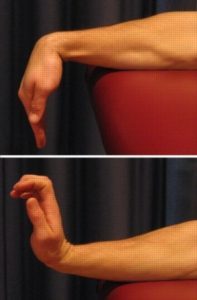
Hand Open and Close
Curl your fingers and thumb aiming to make a tight fist then straighten your fingers. Move in each direction as far as you can go without pain and provided you feel no more than a mild to moderate stretch (figure 3). Begin with 5 repetitions and build up to 20 over a number of days, provided there is no increase in symptoms.
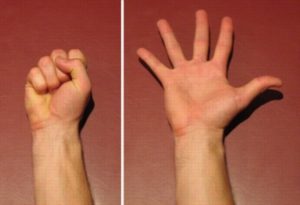
Finger Adduction to Abduction
Begin this exercise with your fingers together as demonstrated (figure 4). Spread your fingers apart as far as you can go without pain and provided you feel no more than a mild to moderate stretch then return to the starting position. Begin with 5 repetitions and build up to 20 over a number of days, provided there is no increase in symptoms.
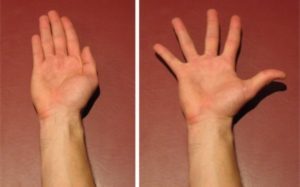

Members Only ContentBecome a PhysioAdvisor Member to gain full access to this exclusive content. For more details see Become a Member. Already a member? Login Now
Other Initial Exercises

Members Only ContentBecome a PhysioAdvisor Member to gain full access to this exclusive content. For more details see Become a Member. Already a member? Login Now
Intermediate Exercises

Members Only ContentBecome a PhysioAdvisor Member to gain full access to this exclusive content. For more details see Become a Member. Already a member? Login Now
Advanced Exercises

Members Only ContentBecome a PhysioAdvisor Member to gain full access to this exclusive content. For more details see Become a Member. Already a member? Login Now
Other Exercises

Members Only ContentBecome a PhysioAdvisor Member to gain full access to this exclusive content. For more details see Become a Member. Already a member? Login Now
Rehabilitation Protocol for a Metacarpal Fracture

Members Only ContentBecome a PhysioAdvisor Member to gain full access to this exclusive content. For more details see Become a Member. Already a member? Login Now
 Physiotherapy products for a metacarpal fracture
Physiotherapy products for a metacarpal fracture
Some of the most commonly recommended products by physiotherapists to hasten healing and speed recovery in patients with a metacarpal fracture include:
To purchase physiotherapy products for a metacarpal fracture click on one of the above links or visit the PhysioAdvisor Shop.
 Other Exercises
Other Exercises
The following exercises may be particularly helpful to restore flexibility and strength following completion of your metacarpal fracture rehabilitation (see protocol above). These should be discussed with your physiotherapist prior to commencement.
- Hand & Finger Flexibility Exercises.
- Hand Strengthening Exercises.
- Wrist Flexibility Exercises.
- Wrist Strengthening Exercises.
- Elbow Flexibility Exercises.
- Elbow Strengthening Exercises.
- Arm Strengthening Exercises.
- Arm Stretches.
 Find a Physio for a metacarpal fracture
Find a Physio for a metacarpal fracture
Find a physiotherapist in your local area who can treat this condition.
 More information for a metacarpal fracture
More information for a metacarpal fracture
- Learn when it’s appropriate to use Ice or Heat.
- View detailed advice on initial injury management including the R.I.C.E. Regime.
- Read about Why your injury may not be improving.
- Review our Wrist and Hand Diagnosis Guide.
- Learn about Mindfulness and how it can help your state of mind and injury.
Become a PhysioAdvisor Member
+ 6 References
PhysioAdvisor relies on credible scientific sources (ideally from systematic reviews of high quality, randomised controlled trials when available) to guide our content creation. Read about our sourcing guidelines and how we create trusted content via our editorial policy.
- Metacarpal Fractures (2018) – www.orthobullets.com/hand/6037/metacarpal-fractures
- Kollitz KM, Hammert WC, Vedder NB, Huang JI. Metacarpal fractures: treatment and complications. Hand (N Y). 2014;9(1):16–23. doi: 10.1007/s11552-013-9562-1.
- Hardy MA. Principles of Metacarpal and Phalangeal Fracture Management: A Review of Rehabilitation Concepts. Journal of Orthopedic and Sports Physical Therapy. 2004; 34:781-791.
- J. J. de Jongel et al, Fractures of the metacarpals. A retrospective analysis of incidence and aetiology and a review of the English-language literature, ‘Department of Traumatology, and ‘Department of Plastic and Reconstructive Surgery, University Hospital Groningen, The Netherlands. Injury, 1994, Vol. 25, 365-369, August.
- Brukner et al (2012). Brukner & Khan’s clinical sports medicine (4th ed.), 439. Australia: McGraw Hill Education.
- Metacarpal Fractures – www.physio-pedia.com/Metacarpal_Fractures

Link to this Page
If you would like to link to this article on your website, simply copy the code below and add it to your page:
<a href="https://physioadvisor.com.au/injuries/wrist-hand/metacarpal-fracture”>Metacarpal Fracture – PhysioAdvisor.com</a><br/>PhysioAdvisor offers detailed physiotherapy information on a metacarpal fracture including: causes, symptoms, diagnosis, treatment, exercises, physiotherapy products and more...
Return to the top of Metacarpal Fracture.






